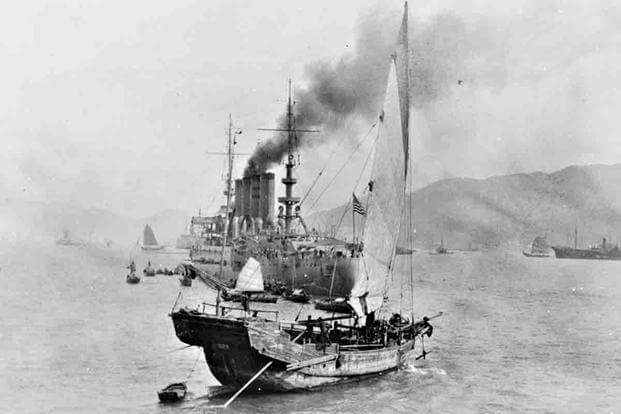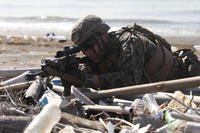World War II changed everything we know about warfare, from the weapons we use to the way we fight. Despite immense technological advancements, the final naval engagement of the war wasn't fought between steel battleships or large aircraft carriers. It was fought between two junks off the coast of China.
Junks were a common sight in that area, especially in the days before the Japanese invasion of China. With wooden hulls and rigid sails, they are perfectly suited for the waters off the Chinese coastline. They are not suited for combat against World War II artillery.
Navy Lt. Cmdr. Livingston Swentzel and Marine Corps 1st Lt. Steuart Pittman were in command of the two junks, traveling from Hainan to Shanghai in August 1945. Seven Americans and 20 Chinese guerrillas were manning the tiny flotilla. Not all of them would make it to Shanghai.
Just days before, this journey would have been perilous. Though Japan was losing in the Pacific Theater, Japanese ships were still aggressively prowling the waters of the East China Sea. But since Emperor Hirohito had announced the surrender of the Japanese Navy and Army on Aug. 15, the sea voyage should have been uneventful.

Swentzel and Pittman spotted another junk in the distance on the morning of Aug. 21. When the mystery junk saw the American ships, it came about and fired a round from a 75-millimeter howitzer. The shot hit Pittman's junk, killing its .30-caliber machine gun crew and the helmsman. The rest of the crew scrambled, not knowing what to do next.
While these junks may have been old technology, they were ready for a more modern kind of combat. The two officers coordinated their counterattack via handheld radios as Swentzel and Pittman took over their respective helms. They got their crews under control and went to work on knocking out their attacker, even as more 75-millimeter shells rained down on them.
Swentzel ran up the colors as their junks moved closer to the enemy ship and the two sides exchanged heavy machine-gun fire. When the Allied ships were within 100 yards, each brought out a bazooka, the heaviest weapons they had. With only a few bazooka rounds between them, they hit the Japanese with everything they could.
The third bazooka round finally knocked out the Japanese howitzer. Low on ammunition but still maneuverable, Swentzel then pressed their advantage, bringing his vessel alongside the Japanese boat and shouting an order to his men to prepare to board.
To prepare for the boarding party, American and Chinese troops began tossing grenades at the enemy vessel, killing many of the 83 Japanese defenders on board. Pittman's crew locked onto the enemy ship and boarded it with rifles and knives drawn. The fight was over almost as quickly as it had begun.
By the time Swentzel's crew also boarded the Japanese junk, the entire engagement had lasted 45 minutes. They met little resistance, considering the bulk of the defending crew had been killed in the bazooka and grenade attacks. Still, they had to drop grenades down the hatches and below decks.
When the smoke cleared and the enemy crew finally surrendered, 44 Japanese soldiers were dead with another 35 wounded and captured. The third junk was secured as they all made their way toward Shanghai.
Swentzel would later receive the Navy Cross and Pittman a Silver Star for the last naval battle of World War II, the last battle between sailing ships and the last naval engagement in which an American prize crew boarded an enemy vessel in combat.
-- Blake Stilwell can be reached at blake.stilwell@military.com. He can also be found on Twitter @blakestilwell or on Facebook.
Want to Learn More About Military Life?
Whether you're thinking of joining the military, looking for post-military careers or keeping up with military life and benefits, Military.com has you covered. Subscribe to Military.com to have military news, updates and resources delivered directly to your inbox.















